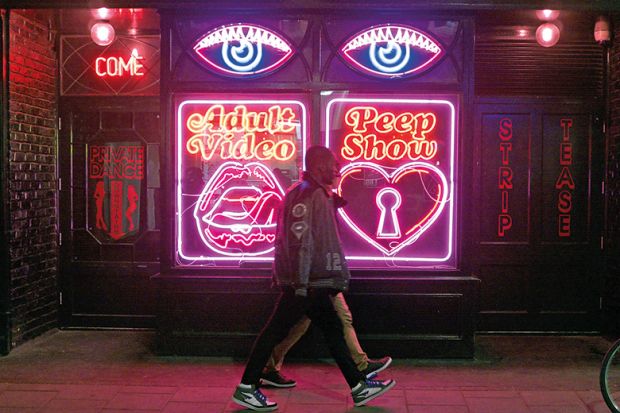Soho has attracted the gaze of scholars and other writers for centuries because of a number of features that distinguish it from other parts of the vast London metropolis: cosmopolitanism; pioneering and high-class cuisine; sleaze; and, by the beginning of the 21st century, a thriving (male) gay scene. Melissa Tyler focuses her book on the third of these and approaches it as a professor of work and organisation studies, meaning that she examines how customers and staff interact in sex shops (but not other types of sex work). She also describes her interdisciplinary approach, which involves history, social science and ethnography.
After explaining how she gravitated towards this subject, Tyler provides an outline of the history of Soho, using just secondary sources quoted at length, making particular use of, for instance, the work of Frank Mort and Judith Walkowitz. She argues that Soho has always had a reputation for sleaze and has attracted a wide range of people seeking a good time. She traces the various phases of the sex industry here, pointing to the fact that Soho reached its sexual height in the second half of the 20th century when Paul Raymond purchased many of the properties here, making him the wealthiest man in Britain.
The book then homes in on the sex shop and those who work in it, as well as their interactions with customers. Tyler utilised an observational ethnographic methodology, which meant spending time in the sex shops over a period of 10 years, as well as interviewing 16 employees, although the voices of some of them do not really come through. She addresses work and interactions through the notion that the workers in such establishments perform “abject” and “dirty” labour and she theorises her own findings in opposition to this.
Tyler also deals with place and spends much time arguing about the uniqueness of this part of London, which throughout its history has maintained a seedy side, although this has gone through many phases. In the early 21st century, while much gentrification has taken place, this sleaziness has not disappeared, certainly not after dark in the parts of Soho where the less reputable sex shops exist. Yet Tyler places too much emphasis on Soho as a unique community, suggesting that it counts many long-time residents, who have moved here because it combines danger with excitement. In reality, as in most of the rest of London, the population has evolved over the decades and there are probably fewer long-term residents than in many other neighbourhoods.
As a young adult in the early 1980s, exploring central London from my parental home in Hornsey, I made sure I avoided Soho, which appeared a scary place and was, according to Tyler, reaching the height of its sleaziness around this time. It still retains an edge, which acts as the focus of this volume, although Tyler in essence ignores the equally interesting aspects of cosmopolitanism and gastronomic innovation.
Panikos Panayi is professor of European history at De Montfort University and the author of Migrant City: A New History of London (2020).
Soho at Work: Pleasure and Place in Contemporary London
By Melissa Tyler
Cambridge University Press, 248pp, £22.99
ISBN 9781316635599
Published 19 December 2019
Register to continue
Why register?
- Registration is free and only takes a moment
- Once registered, you can read 3 articles a month
- Sign up for our newsletter
Subscribe
Or subscribe for unlimited access to:
- Unlimited access to news, views, insights & reviews
- Digital editions
- Digital access to THE’s university and college rankings analysis
Already registered or a current subscriber? Login







